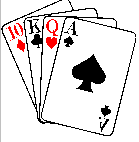 Vol. 3, No. 2, 1997 Page 1
Vol. 3, No. 2, 1997 Page 1 
 Vol. 3, No. 2, 1997 Page 1
Vol. 3, No. 2, 1997 Page 1 |

Gambling is a common vice of criminals, with as many as 13% of prisoners claiming that their crimes were committed to obtain money to pay off gambling debts. New research suggests that many of these individuals have biological flaws that predispose them both to gambling and to the criminal behavior that often results.
Lori Rugle recently reported that compulsive gamblers have a high rate of attention deficit disorder (ADD), a problem also considered by some researchers to be a factor in delinquency and criminality. Rugle found that using strict criteria for ADD, she could classify about 30% of compulsive gamblers as having ADD. Based on the gamblers' own reports of their behavior, as many as 43% met criteria for the disorder. "I knew that gamblers had features of ADD," Rugle noted in the Addiction Letter, "but I was surprised that the numbers were so high for those who met diagnostic criteria based on DSM-IV."
 A team of researchers in Spain and the U.S. report evidence of another
biological anomaly among compulsive gamblers. Carlos Blanco and colleagues
measured platelet monoamine oxidase (MAO) activity in 27 male pathological
gamblers, comparing them to non-gamblers matched for age, sex, and smoking
habits (since smoking lowers MAO activity). Activity of the enzyme MAO is
believed to be an indicator of serotonin turnover in the central nervous
system, and abnormal serotonin levels in turn are linked to abnormal
behaviors including impulsiveness, aggression, compulsive behaviors, and
depression (See related article, Crime Times, Vol. 3, No. 2, Page 7).
A team of researchers in Spain and the U.S. report evidence of another
biological anomaly among compulsive gamblers. Carlos Blanco and colleagues
measured platelet monoamine oxidase (MAO) activity in 27 male pathological
gamblers, comparing them to non-gamblers matched for age, sex, and smoking
habits (since smoking lowers MAO activity). Activity of the enzyme MAO is
believed to be an indicator of serotonin turnover in the central nervous
system, and abnormal serotonin levels in turn are linked to abnormal
behaviors including impulsiveness, aggression, compulsive behaviors, and
depression (See related article, Crime Times, Vol. 3, No. 2, Page 7).
The researchers found that "platelet MAO activity was significantly lower in male pathological gamblers than in the comparison group." Because participants were not actively gambling at the time of the study, Blanco and colleagues say that "low platelet MAO activity may be best understood as a trait marker rather than a state marker."
Yet more evidence of gambling's possible biological underpinnings comes from David Comings and associates, who report that half of the pathological gamblers they have studied carry a dopamine [D.sub.2] receptor variant which has tentatively been linked to compulsive behaviors ranging from over-eating to alcoholism. Only about 25 percent of the general population have this gene variant. "The more severe the gambling problem," Comings and colleagues say, "the more likely it was that the individual was a carrier of [this gene variant]." They add that "in a population of males with drug problems who were also pathological gamblers, the incidence of [this variant] rose to 76 percent."
 The new view of gambling as a behavior at least partially mediated by
biology is leading to new treatments. Walter Alexander recently reported
that the drug fluvoxamine (Luvox), which increases the availability of
serotonin in the brain, appears to be useful in treating pathological
gambling, and other physicians are reporting success with the serotonin-
enhancing drug fluoxetine (Prozac).
The new view of gambling as a behavior at least partially mediated by
biology is leading to new treatments. Walter Alexander recently reported
that the drug fluvoxamine (Luvox), which increases the availability of
serotonin in the brain, appears to be useful in treating pathological
gambling, and other physicians are reporting success with the serotonin-
enhancing drug fluoxetine (Prozac).
"Pathological gambling and platelet MAO activity: a psychobiological study," Carlos Blanco, Luis Orensanz-Muñoz, Carmen Blanco-Jerez, and Jerónimo Saiz- Ruiz, American Journal of Psychiatry, Vol. 153, No. 1, January 1996, pp.119-121. Address: Carlos Blanco, Dept. of Psychiatry, St. Vincent's Hospital and Medical Center, 144 W. 12th St., New York, NY 10011.
"SRIs found to be helpful in treating OCD," Walter Alexander, Drug Topics, Vol. 140, No. 4, Feb. 19, 1996, pp. 56-58.
"The molecular genetics of pathological gambling: the DRD2 gene," D. E. Comings, R. J. Rosenthal, H. R. Leiseur, L. Rugle, D. Muhleman, C. Chiu, F. Dietz, and R. Gane, Pharmacogenetics, 1996.
"Check compulsive gamblers for attention-deficit symptoms," Kim Steffgen, The Addiction Letter, Vol. 11, No. 12, Dec. 1995, pp. 1-2.
